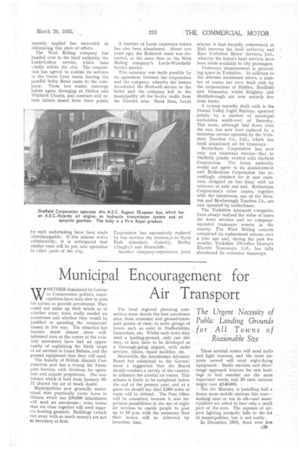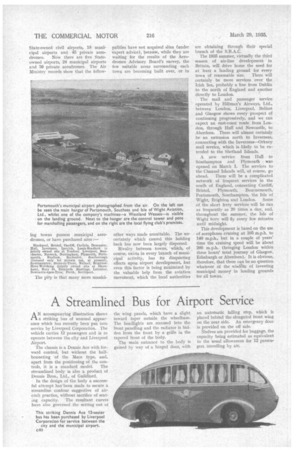Municipal Encouragement for Air Transport
Page 93

Page 94

If you've noticed an error in this article please click here to report it so we can fix it.
WHETHER dominated by Labour or Conservative politics, municipalities have been slow to take the advice to provide aerodromes. They could not make up their mind's as to whether every town really needed an aerodrome and whether they would be justified in spending the ratepayers' money in this way. The situation has become nitieh clearer " since Wellinformed men at,the centre of the aviation` mOVernent have had in opportunity of explaining" the likely "Scope of air services in Great Britain, and the ground equipment' that they will need.
The Society of British Aircraft Constructors now has a. strong Air Transport Section, with divisions for operators and airport proprietors. The conference which it held from ./anuary 1012 cleared the air of much doubt.
Municipalities now generally understand that practically every town in Britain which has 100,000 inhabitants will need an aerodrome ; even towns that are close together will need separate landing grounds. Buildings (which run away with so much money) are not so necessary at first. The local regional planning committees must decide the best aerodrome sites, from economic and ground-transport points of view, to serve groups of towns such as exist in Staffordshire, Lancashire, etc, Whilst each toWn may need a landing-ground, only one site may, at first, have to be developed as a' thorough-going airport, with radio services, offices, repair facilities, etc.
Meanwhile, the Aerodromes Advisory Board has submitted to the Government a suggestion that the Board should conduct a survey of the country to delineate the arterial air routes. This scheme is likely to be completed before the end of the present year, and at a guess we should say that .2,000 miles of route will be defined. The Post Office will he consulted, because it sees important possibilities in the use of night air 'services to enable people to post up to 10 p.m. with the assurance that their fetters will be delivered by breakfast time.
The,se arterial routes will need radio and light beacons; and the main airports served will need night-flying equipment. Radio statiOns and short-range approach beacons for safe landings in bad weather are the most important needs, and 20 such stations might cost £140,000.
The Air Ministry is installing half a dozen more mobile stations this year— making nine or ten in all—and municipalities are asked to bear only a small part of the cost. The expense of air-, port lighting normally falls to the lot _ of municipalities, but is not costly.
In December, 1983, there were five
State-owned civil airports, 18 municipal airports and 45 private aero
dromes. Now there are five Stateowned airports, 24 municipal airports and 59 private aerodromes. The Air Ministry records show that the follow
ing towns possess municipal aerodromes, or have purchased sites :—
Blackpool, Bristol, Cardiff, Carlisle, Doncaster, Hull, Inverness, Ipswich, Leeds-Bradford Is jointly owned site at Yeadon) Liverpool, Manchester, Norwich, Nottingham, Plymouth, Portsmouth, Renfrew, Rochester, Scarborough (licensed only for private use, at present), Southampton, Stoke-on-Trent, Walsall, BrightonHove-Worthing (jointly owned site at Shoreham), Bury St. Edmunds Hastings, Leicester, Neweastle-upon-Tyne, Perth, Southport.
The pity is that many more munici palities have not acquired sites (under expert advice), because, while they are waiting for the results of the Aerodromes Advisory Board's survey, the few suitable areas surrounding each town are becoming built over, or in other ways made unsuitable. The uncertainty which caused this holding back has now been largely dispersed.
Rivalry between towns, which, of course, exists in every branch of municipal activity, has its disquieting effects upon airport development, but even this factor is being minimized by the valuable help from the aviation movement, which the local authorities are obtaining through their special branch of the S.B.A.C.
The 1935 summer, virtually the third season of air-line development in Britain, will drive home the need for at least a landing ground for every town of reasonable size. There will certainly be more services over the Irish Sea, probably a line from Dublin to the north of England and another directly to London.
The mail and passenger service operated by Hillman's Airways, Ltd., between London, Liverpool, Belfast and Glasgow shows every prospect of continuing progressively, and we can expect an east-coast route from London, through Hull and Newcastle, to Aberdeen. There will almost certainly be an extension north to Inverness, connecting with the Inverness—Orkney mail service, which is likely to be extended to the Shetland Islands.
A new ;service from Hull to Southampton and Plymouth was opened on March 1. The services to the Channel Islands will, of course, go ahead. There will be a complicated network of frequent services in the south of England, connecting Cardiff, Bristol, Plymouth; Bournemouth, Portsmouth, Southampton, the Isle of Wight, Brighton and London. Some of the short ferry services will be run as frequently as 20 times a day, and, throughout the summer, the Isle of Wight ferry will fly every few minutes until midnight.
This development is based on the use of aeroplanes cruising at 105 m.p.h. to 140 m.p.h., but in a couple of years' time the cruising speed will be about 200 m.p.h. (bringing London within three hours' total journey of Glasgow, Edinburgh or Aberdeen). It is obvious, therefore, that there can be no question whatever of the wisdNi of investing municipal money in landing grounds for all towns.




































































































































































